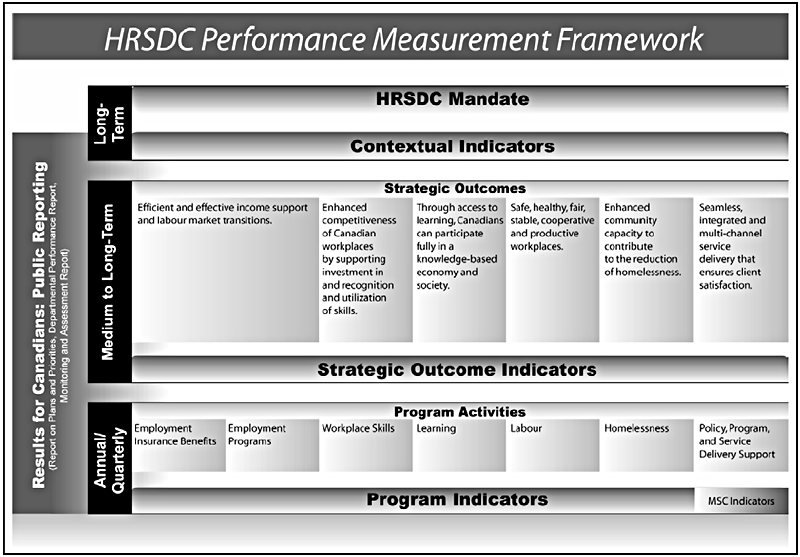
| Français | Contact Us | Help | Search | Canada Site |
| About Us | Services Where You Live | Policies & Programs | A-Z Index | Home |

Supplementary Information on 2004-2005 Performance Indicators Human Resources and Skills Development Canada - October 2004 |
|
|
|
|
Services for:
|
The purpose of this document is to provide a brief description of Human Resources and Skills Development Canada's (HRSDC) Performance Measurement Framework and supplementary information relating to Strategic Outcome Indicators and Program Indicators that appear in the HRSDC 2004-2005 Report on Plans and Priorities (RPP). Supplementary information includes data sources, explanatory notes and additional details.
Performance Measurement Framework
Performance measurement is a critical tool to enable a department to focus on achieving results and demonstrating how programs and services benefit Canadians. With a new mandate and business lines, HRSDC has undertaken a comprehensive review to establish a new departmental performance measurement framework. This framework will facilitate both monitoring and reporting of results. The department is working to identify long, medium and shorter-term indicators that reflect its mandate and are aligned with its strategic outcomes, policies and programs.

First, to measure performance, it is important to understand the environment in which the department delivers its programs and services. Contextual indicators describe the demographic, economic, labour market and social environment and are found in the Planning Overview section of the HRSDC 2004-2005 RPP. Contextual indicators, such as population growth and level of economic activity, are outside of HRSDC's sphere of influence, but serve to frame HRSDC's environment and influence the set of policy and delivery options available.
Secondly, a set of indicators is needed to measure progress toward the strategic outcomes of the department. Strategic outcomes are the enduring benefits HRSDC is working to achieve on behalf of Canadians, in conjunction with other parties. Strategic outcome indicators, such as the percentage of unemployed Canadians looking for work for more than one year, are broad measures that help to track progress toward achieving the identified strategic outcomes over the medium to long term. HRSDC policies and programs will be assessed in light of their contribution toward achieving these strategic outcomes. HRSDC is not the only influence on these outcomes - governments, along with key stakeholders and external factors play an important role. For example, the percentage of Canadians 18-24 years-old who attend university or community college is not only dependent on a range of HRSDC programs; it is also significantly influenced by the economy, employment and interest rates, as well as policies and programs of provinces and the actions of universities, colleges and individuals. Likewise, the labour programs of the department, while directly impacting workplaces under federal jurisdiction such as transportation and financial institutions, only form a small component of the overall Canadian workplace. HRSDC will continue to work on this set of indicators over the next year.
Finally, HRSDC needs to renew the program indicators used in the former Human Resources Development Canada (HRDC) department to demonstrate that HRSDC is effectively managing programs and services. The program indicators are intended to provide detailed, shorter-term results used for monitoring and improving programs and services - for instance, the percentage of accurate EI payments. The department is relying on the existing set of program indicators for this report, but will substantially review them over the coming year.
Supplementary Information
The list of HRSDC strategic outcome and program indicators contained in the 2004-2005 RPP can be found below in the left hand column. The column on the right includes information on sources and additional notes. All administrative data is for 2004-2005 except where noted.
| Efficient and effective income support and labour market transitions | |
| Strategic Outcome Indicators: | |
Average percentage of unemployed looking for work (2003-2004):
|
SOURCE: Labour Force Survey and HRSDC calculations. |
| Percent of unemployed targeted by Employment Insurance program potentially eligible to collect employment insurance: 2003 = 83.7% | SOURCE: Employment Insurance Coverage Survey. See Statistics Canada's The Daily of June 22, 2004, at http://www.statcan.ca/Daily/English/040622/d040622c.htm. |
| Increased duration of employment for participants in active employment measures: actual results to be reported when data becomes available. | To come. |
| Increased earnings for participants in active employment measures: actual results to be reported when data becomes available. | To come. |
| Average proportion of young Canadians (15-24 years-old) who are in school or in employment = 90% | SOURCE: Labour Force Survey and HRSDC calculations; average computed over the school-year months of September 2003 to March 2004. |
| Program Indicators: | |
| Employment Insurance Benefits | |
|
SOURCE: HRSDC administrative data. |
|
SOURCE: HRSDC administrative data. |
|
SOURCE: HRSDC administrative data. |
|
SOURCE: HRSDC administrative data. |
|
SOURCE: HRSDC administrative data. |
|
SOURCE: HRSDC administrative data. |
| Employment Programs | |
|
SOURCE: HRSDC administrative data. NOTE: |
|
SOURCE: HRSDC administrative data. |
|
SOURCE: HRSDC administrative data. |
|
SOURCE: HRSDC administrative data. NOTE: |
| Enhanced competitiveness of Canadian workplaces by supporting investment in and recognition and utilization of skills | |
| Strategic Outcome Indicators: | |
|
SOURCE: Statistics Canada, Canadian economic accounts quarterly review, first quarter 2004, Catalogue no 13-010-XIE. |
|
SOURCE: Statistics Canada, Working and training: First results of the 2003 Adult Education and Training Survey, Cat. No 81-595 MIE, no 15, April 2004. |
|
SOURCE: Statistics Canada, Working and training: First results of the 2003 Adult Education and Training Survey, Cat. No 81-595 MIE, no 15, April 2004. |
|
SOURCE: 2001 Census - Statistics Canada 97F0019XCB01056; released on July 24, 2003; based on average wages and salary earnings, for recent immigrants (1995-1999) and for Canadian-born. |
| Program Indicators: | |
| Workplace Skills | |
|
SOURCE: HRSDC administrative data. |
|
SOURCE: HRSDC administrative data. |
| Through access to learning, Canadians can participate fully in a knowledge-based economy and society | |||||||||||||||||||||||||||||||||
| Strategic Outcome Indicators: | |||||||||||||||||||||||||||||||||
|
SOURCE: Labour Force Survey. | ||||||||||||||||||||||||||||||||
|
SOURCE: Adult Education Training Survey, HRSDC calculations. |
||||||||||||||||||||||||||||||||
|
SOURCE: Corak, Miles, Garth Lipps, and John Zhao (2003). Family income and participation in postsecondary education, Analytical Studies Branch Research Paper Series, catalogue number 11F0019MIE, no 210, Statistics Canada. | ||||||||||||||||||||||||||||||||
|
SOURCE: Labour Force Survey and HRSDC calculations; average computed over the school-year months of September 2003 to March 2004. | ||||||||||||||||||||||||||||||||
| Program Indicators: | |||||||||||||||||||||||||||||||||
| Learning | |||||||||||||||||||||||||||||||||
|
SOURCE: HRSDC administrative data. | ||||||||||||||||||||||||||||||||
|
SOURCE: HRSDC administrative data. | ||||||||||||||||||||||||||||||||
|
SOURCE: HRSDC administrative data. | ||||||||||||||||||||||||||||||||
|
SOURCE: HRSDC administrative data. | ||||||||||||||||||||||||||||||||
|
SOURCE: HRSDC administrative data. Note: |
||||||||||||||||||||||||||||||||
| Safe, healthy, fair, stable, cooperative and productive workplaces | |
| Strategic Outcome Indicators: | |
|
SOURCE: Labour Force Survey,
Statistics Canada, CANSIM Table
279-0029.
Note: |
|
SOURCE: HRSDC, Labour Program, Occupational Health, Safety and Compensation. |
|
SOURCE: HRSDC, Labour Program, Workplace Information. |
| Program Indicators: | |
| Labour | |
|
SOURCE: HRSDC administrative data. |
|
SOURCE: HRSDC administrative data. |
|
SOURCE: HRSDC administrative data. |
| Enhanced community capacity to contribute to the reduction of homelessness | |
| Strategic Outcome Indicators and Program Indicators. | |
| To come. | |
| Seamless, integrated and multi-channel service delivery that ensures client satisfaction | |
| Strategic Outcome Indicators: | |
|
SOURCE: Human Resources Development Canada Client Satisfaction Surveys |
|
June-July 2001 |
|
February-March 2002 |
|
February-March 2002 |
|
January-February 2003 |
| Program Indicators: | |
| NOTE: Modernizing Service for Canadians indicators to measure service delivery are being developed. |
|
| Departmental Human Resources | |
|
NOTE: In addition to the indicators listed in the above strategic outcomes, HRSDC will also report actual results for these HRSDC workforce indicators. |
| Last modified : 2005-08-26 | top | Important Notices |